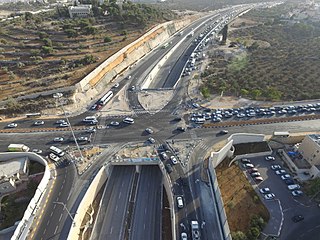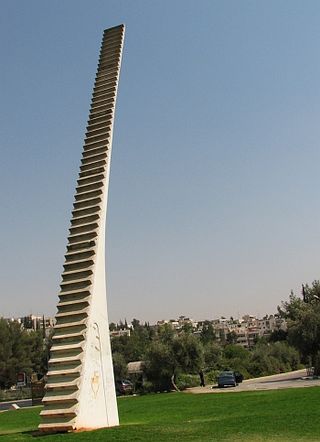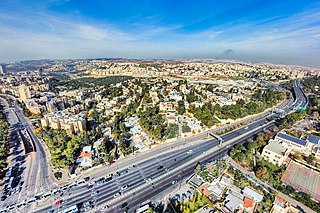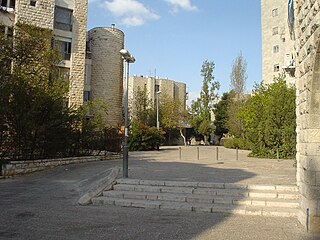
Levi Eshkol, born Levi Yitzhak Shkolnik, was an Israeli statesman who served as the third Prime Minister of Israel from 1963 until his death from a heart attack in 1969. A founder of the Israeli Labor Party, he served in numerous senior roles, including Minister of Defense (1963–1967) and Minister of Finance (1952–1963).

The Hebrew University of Jerusalem is an Israeli public research university based in Jerusalem. Co-founded by Albert Einstein and Chaim Weizmann in July 1918, the public university officially opened on 1 April 1925. It is the second-oldest Israeli university, having been founded 30 years before the establishment of the State of Israel but six years after the older Technion university. The HUJI has three campuses in Jerusalem, one in Rehovot, one in Rishon LeZion and one in Eilat. Until 2023, the world's largest library for Jewish studies—the National Library of Israel—was located on its Edmond J. Safra campus in the Givat Ram neighbourhood of Jerusalem.

Beit Shemesh is a city located approximately 30 kilometres (19 mi) west of Jerusalem in Israel's Jerusalem District. A center of Haredi Judaism and Modern Orthodoxy, Beit Shemesh has a population of 170,683 as of 2024.

Mount Scopus is a mountain in northeast Jerusalem.

Efrat, or previously officially Efrata, is an Israeli settlement in the West Bank, established in 1983 in the Judean Mountains. Efrat is located 12 kilometers (7.5 mi) south of Jerusalem, between Bethlehem and Hebron, 6.5 km (4 mi) east of the Green Line, at the Palestinian side of the West Bank wall. The settlement stands at an altitude of up to 960 metres above sea level and covers about 6,000 dunam. The international community has largely viewed Israeli settlements in the West Bank, referred to by Israel as Judea and Samaria, as illegal under international law. However, Israel disputes this interpretation and maintains that settlements are legal and consistent with international law, citing historical, legal, and security reasons. This position has been upheld by successive Israeli governments.

French Hill, also Giv'at Shapira, is an Israeli settlement in northern East Jerusalem. It is located on territory that has been occupied since the Six-Day War in 1967 and later unilaterally annexed by Israel under the Jerusalem Law, in a move internationally condemned as illegal, "null and void" under international law, in 1980. The international community considers Israeli settlements in East Jerusalem, such as French Hill, illegal under international law, which the Israeli government disputes.

Highway 50, officially called Begin Boulevard and also referred to as Menachem Begin Expressway or Begin Highway, is a north-south urban freeway, through western Jerusalem, named after Israel's sixth Prime Minister, Menachem Begin. Local Jerusalemites simply refer to it as 'Begin'. It enters Area C of the West Bank on the north end and East Jerusalem on both ends.

Givat Mordechai is a Jewish neighborhood in southwest-central Jerusalem, midway between the neighborhoods of Nayot and Malcha. The neighborhood was named after an American philanthropist, Maxwell (Mordechai) Abbell of Chicago.

Al-Issawiya is a Palestinian neighborhood in East Jerusalem. It is located on the eastern slopes of the Mount Scopus ridge. To the east and north, it is bordered by Road 1, which connects Jerusalem with the settlement of Ma’ale Adumim; immediately adjoining it to the north, west and southwest are the Hadassah Medical Center, the Hebrew University campus, the Jewish settlement of French Hill and the Ofarit military base; to the south, there is a planned park, the Mount Scopus slopes national park.

Sanhedria is a neighborhood in northern Jerusalem. It lies east of Golda Meir Street, adjacent to Ramat Eshkol, Shmuel HaNavi, Maalot Dafna and the Sanhedria Cemetery.

Shmuel HaNavi is a neighborhood in north-central Jerusalem. It is bordered by the Sanhedria Cemetery to the north, Maalot Dafna to the east, Arzei HaBira to the south, and the Bukharan Quarter to the west. It is named after Shmuel HaNavi Street, which runs along its western border and is the main road leading to the tomb of Samuel the prophet just outside Jerusalem's city limits.

Givat HaMivtar is an Israeli settlement and a neighborhood in East Jerusalem established in 1970 between Ramat Eshkol and French Hill. It is located on a hill where an important battle took place in the Six Day War. Archaeological excavations have revealed important ancient Jewish tombs in the region. Givat Hamivtar was one of the first "Build Your Own Home" neighborhoods in Jerusalem.

Ma'alot Dafna is an Israeli settlement and a neighborhood in East Jerusalem. It borders the neighborhood of Shmuel HaNavi to the west, Ammunition Hill to the east, Ramat Eshkol to the north and Arzei HaBira to the south.

Events in the year 1948 in the British Mandate of Palestine.

Route 417 is an intercity road in Israel and the West Bank that stretches from the west side of Jerusalem to Ma'ale Adumim and Highway 1 east to the Jordan Valley.

Shmuel HaNavi Street is a main road in north-central Jerusalem. It starts at the intersection of St. George and Shivtei Israel Streets near Highway 60, and merges into Golda Meir Boulevard just past the intersection of Bar-Ilan and Hativat Harel Streets. The continuation of the street winds up to the tomb of Samuel the prophet, after whom the street is named.

Sanhedria Cemetery is a 27-dunam (6.67-acre) Jewish burial ground in the Sanhedria neighborhood of Jerusalem, adjacent to the intersection of Levi Eshkol Boulevard, Shmuel HaNavi Street, and Bar-Ilan Street. Unlike the Mount of Olives and Har HaMenuchot cemeteries that are located on the outer edges of the city, Sanhedria Cemetery is situated in the heart of western Jerusalem, in proximity to residential housing. It is operated under the jurisdiction of the Kehilat Yerushalayim chevra kadisha and accepts Jews from all religious communities. As of the 2000s, the cemetery is nearly filled to capacity.

City Line is the name given to a segment of the Green Line that divided the city of Jerusalem from 1948 to 1967. It was 7 km in length, and constituted a temporary boundary line in accordance with Israel's Armistice Agreement with Jordan, which divided the city between East Jerusalem which was part of the Kingdom of Jordan, and West Jerusalem, the capital of the State of Israel. The Old City bordered the City line on the east side, and thus had been part of the "Jordanian Jerusalem". On both sides of the City line fortifications and obstacles were deployed, and different buildings in the city along the line were used as military posts.























